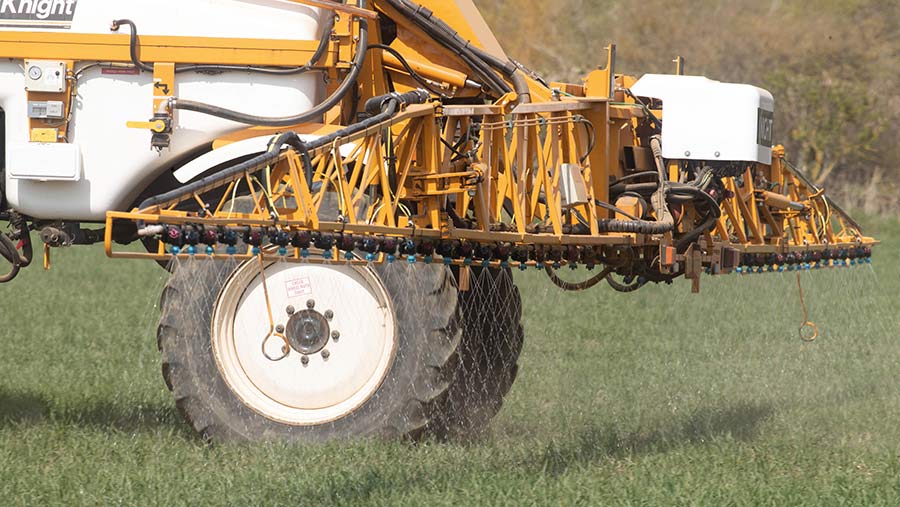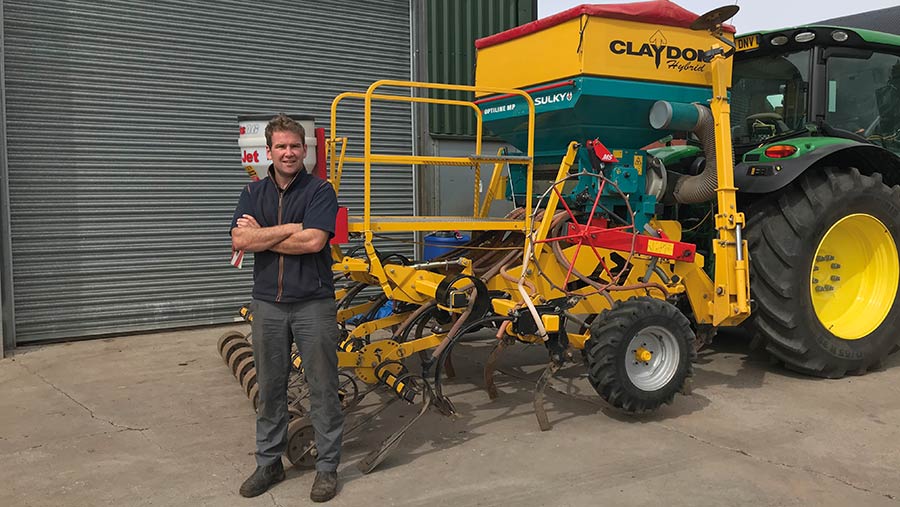Regenerative Agriculture: How to start reducing crop inputs
 © Tim Scrivener
© Tim Scrivener Cutting inputs and costs is a common goal for growers making the first steps into regenerative farming.
As it is a systems approach, the first stage is to build healthier, more resilient soils that are full of biological life.
These soils will then start to cycle nutrients to feed the plants, as well as cope with extreme weather events.
In time, crops grown in soils that are functioning well require less intervention, providing opportunities to reduce fertiliser and crop protection inputs.
See also: Biofungicide farm trial: What it means for septoria control
Base phosphorus (P) and potassium (K) applications are usually among the first to fall, but the current economic climate and recent price hike means that there is also huge interest in bringing nitrogen (N) rates down.
At N rates above 180kg/ha, pursuing a regenerative approach becomes more difficult and places greater reliance on chemistry – something that farmers such as Tom Sewell from Kent, current Soil Farmer of the Year, are keen to avoid.
“The link between fungicide and fertiliser use is strong,” he says. “As nitrogen is reduced, the plants become less vulnerable to attack and fungicides can also be scaled back. They work in conjunction – it’s not an overnight process.”
Nitrogen fertilisers can affect the carbon-to-nitrogen (C:N) ratio that soil bacteria require to thrive – increasing their need for carbon, which they find from organic matter at the expense of soil health.
Applying nitrogen with a carbon source, such as molasses, will help. It maintains the C:N ratio, protecting the soil and helping to hold the nitrogen in the root zone until it is taken up.
The use of humic and fulvic acid with nitrogen applications is often practised too, for their role in increasing nitrogen-use efficiency.
Insecticides are another early target in regenerative systems. With a limited number of products on the market and rising resistance levels among pests, their use is often ineffective.
Farmers Weekly spoke to two growers who are reducing their use of inputs – one who describes himself as just starting out, the other who has more experience:
Rick Davies, Newton Lodge Farms

Rick Davies © AHDB
Northampton Monitor Farm host Rick Davies has started on his regenerative journey, but freely admits that it’s been hard to change.
He has made savings on herbicides and insecticides, as well as phosphorus and potassium, but feels that nitrogen reductions are still beyond his reach.
Even so, he is questioning what he is doing on a daily basis.
Mr Davies has been using strip tillage since 2012 at Newton Lodge Farms, makes around 500t of his own compost, spreads sewage cake annually and incorporates cover cropping where possible.
As a result, soil organic matter levels have risen, the water holding capacity and drought tolerance of his soil have improved and some inputs are being scaled back.
“The soil microbial activity is helping with micronutrient availability,” he says. “We are less reliant on chemistry than we were and our net margins have improved.”
Fungicide costs in wheat are £80-90/ha, herbicide expenditure has dropped from £60/ha to £10/ha as chemicals have been replaced by hand roguing and the use of bagged fertilisers is coming down.
One barley yellow dwarf virus insecticide was applied to early drilled wheat last year, but none are used on his beans and efforts are being made to support beneficial insect populations.
His plans for the future include bringing more species diversity into his cover crops, importing more nutrition/soil organic matter and making better use of sheep, as he continues to make progress.
Michael Kavanagh, Church Farm

Michael Kavanagh © Lucinda Dann
Input use has fallen dramatically since Shropshire farm manager Michael Kavanagh took on the challenge of building a profitable and sustainable business seven years ago.
Having made incremental changes every year to the 200ha of arable crops produced at Church Farm, he only used one fungicide on his winter wheat last year and nitrogen use is down to 165kg/ha.
All of his crops are established with zero tillage and no seed treatments, insecticides, plant growth regulators or phosphorus and potassium fertilisers are applied across the winter wheat, oats, spring barley, oilseed rape and quinoa grown.
Not content to stop there, Mr Kavanagh is determined to crack his zero fungicides target and will continue to look for ways to bring nitrogen use down – with both foliar nitrogen and white clover being trialled this year.
Wheat blend
He is also trying out a four-way milling variety blend and some Heritage wheat, while hoping to make progress with monetising carbon and biodiversity.
“That’s a hot topic at the moment,” he acknowledges. “This farm is surpassing net zero by 500-750t of carbon per year, so we are busy collating all the facts and figures to back that up.”
The starting point of his journey – back in 2015 – was the purchase of a Claydon drill and the establishment of an extensively run sheep enterprise, which has since been integrated with the arable operations.
The next big step was changing his agronomist, recalls Mr Kavanagh.
“By switching to an Eadaphos agronomist in 2016, I started to be challenged and encouraged to do more to develop a biological system based on soil health.”
As a result, cover crops were introduced and the focus was put on nutrition, to keep plants healthy and able to withstand attack by pests and diseases.
The use of biological products began, so that soil microbes could function well and a gradual reduction in nitrogen inputs could be implemented.
“It’s a balancing act and it continues to be a challenge,” he admits.
“Organic matter is essential for soil microbes, so I’ve always had the goal of driving up soil organic matter levels and have made good use of muck for that purpose.”
As a result, he has seen soil organic matter levels rise from 2.5% to 3.25% in six years.
Widening the rotation took place in 2018, with both beans and quinoa introduced. That latter has proved tricky, but he persevered with it and his quinoa yields are now about 1.5t/ha.
The following year he managed to get all the lambs finished without the use of concentrates, while 2020 was his first harvest of all crops established without the use of tillage.
Muck deal
In 2021, he reached agreement on a straw for muck deal, which will allow him to keep the focus on soil biology.
With his aim of eliminating fungicides completely, good use is made of silicon for plant health, and a tailored nutritional package is applied to crops based on the results of tissue tests.
He also uses a biological brew containing six types of bacteria every time he goes through crops, which is how his T3 “treatment” costs just £1.50/ha.
Nitrogen rates have been reduced by including Nurture N with his liquid urea/ammonium nitrate, which contains fermented molasses along with humic and fulvic acid.
These help to limit leaching and improve nitrogen use efficiency, allowing rates to come down by one-third.
This year, he will try foliar-applied amide nitrogen, which is up to 90% efficient, and plans to only soil apply the first 30kg to his winter wheat.
Wheat yields have been as much as 10t/ha following quinoa and, with the exception of spring barley, all his crop gross margins are in excess of £1,000/ha.
The business’s variable costs are £334/ha on wheat, £185/ha for oats, £274/ha in spring barley and £361/ha for oilseed rape.
Regenerative Agriculture series – Making the Change
This is the third article in a five-part series on how to introduce regenerative agriculture. The other articles include building carbon-rich soils, designing a diverse ration, reducing your reliance on the can/bag and introducing livestock to the system.
See previous pieces:

